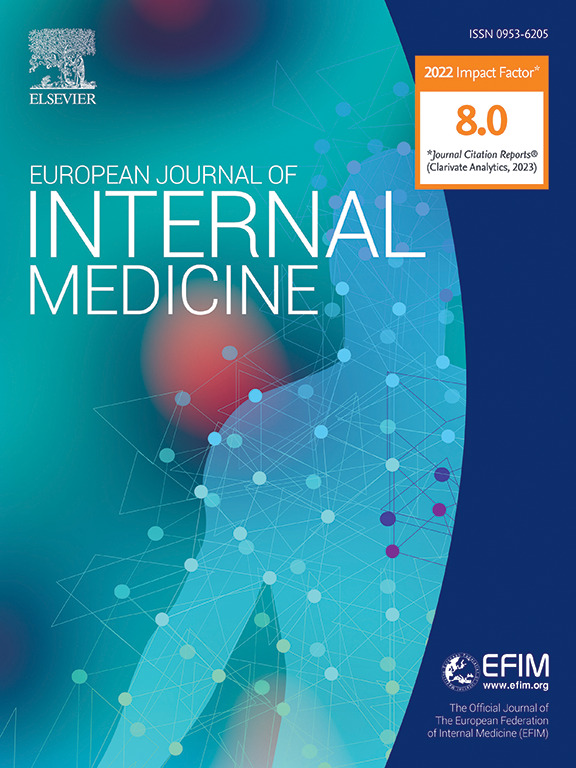房颤中健康的性别社会决定因素和主要不良后果的风险。
IF 5.9
2区 医学
Q1 MEDICINE, GENERAL & INTERNAL
引用次数: 0
摘要
心房颤动(AF)与不良结局风险增加相关。临床风险因素已被确定为这些结果的预测因素,但健康的社会决定因素(SDOH)也可能发挥作用。我们评估了性别SDOH(性别间不均匀分布)与房颤不良结局之间的关系。方法:这是一项回顾性队列研究,使用来自欧洲27个国家250个中心的房颤患者登记数据。性别的SDOH包括教育程度、生活状况、EQ-5D-5L问卷子量表、行为因素和国家级性别不平等指数(GII)。主要结局是主要不良心血管事件和全因死亡率的综合结果。我们使用多元逻辑回归模型来确定SDOH与主要结局之间的关联。结果:研究人群包括11096例患者(平均年龄69.2岁;40.7%女性),其中75.6%的患者具有高危CHA2DS2-VASc评分。大多数参与者受过中等教育,缺乏体育锻炼,生活在性别平等的国家,报告的生活质量指标至少适度提高;他们不太可能独自生活、吸烟或喝酒。调整临床因素后,没有受过高等教育(OR:1.17 95% CI:1.05-1.28)、报告健康状况较差(OR:1.08 95% CI:1.05-1.11)、生活在GII较高的国家(性别不平等程度较高)(OR:1.12 95% CI:1.03-1.22各0.100)、报告活动能力降低(OR:1.18 95% CI:1.02-1.38)和自我护理能力降低(OR:1.35; 95% CI:1.14-1.61)与较差的结果独立相关。结论:性别SDOH与房颤患者的不良事件独立相关。在评估风险时应考虑这些因素,并将其作为改善预后的干预措施的潜在目标。摘要:房颤(AF)与不良结局和健康的社会决定因素(SDOH)相关,其中性别可能预测房颤的不良结局。我们使用了来自27个欧洲国家的房颤患者登记。多因素logistic回归用于研究性别SDOH与主要结局(主要不良心血管事件和全因死亡率的组合)之间的关系。一些SDOH是独立的预测因子:没有受过高等教育(OR:1.17; 95% CI:1.05-1.28)、健康状况较差(OR:1.08; 95% CI:1.05-1.11)、较高的GII (OR:1.12; 95% CI:1.03-1.22,各0.100)、活动能力降低(OR:1.18; 95% CI:1.02-1.38)和自我护理能力降低(OR:1.35; 95% CI:1.14-1.61)。性别SDOH与房颤不良事件独立相关。本文章由计算机程序翻译,如有差异,请以英文原文为准。

Gendered social determinants of health and risk of major adverse outcomes in atrial fibrillation
Introduction
Atrial fibrillation (AF) is associated with an increased risk of adverse outcomes. Clinical risk factors have been identified as predictors of such outcomes, but social determinants of health (SDOH) may also play a role. We evaluated the associations between gendered SDOH (unevenly distributed between sexes) and adverse outcomes in AF.
Methods
This is a retrospective cohort study using data from a European registry of AF patients from 250 centers and twenty-seven countries. Gendered SDOH included education, living status, subscales of the EQ-5D-5L questionnaire, behavioral factors, and country-level gender inequality index (GII). The primary outcome was a composite of major adverse cardiovascular events and all-cause mortality. We used multivariate logistic regression models to identify associations between SDOH and the primary outcome.
Results
The study population comprised of 11,096 patients (mean age 69.2 years; 40.7 % females), with 75.6 % of patients having a high-risk CHA2DS2-VASc score. Most participants had secondary education, were physically inactive, lived in countries with gender equity and reported at least moderately elevated quality of life measures; they were less likely to live alone, smoke or drink alcohol. After adjustment for clinical factors, not having any post-secondary education (OR:1.17 95 %CI:1.05–1.28), reporting poorer health status (OR:1.08 95 %CI:1.05–1.11), living in a country with a higher GII (higher gender inequity) (OR:1.12 95 %CI:1.03–1.22 each 0.100), reporting reduced mobility (OR:1.18 95 %CI:1.02–1.38) and reduced self-care (OR:1.35;95 %CI:1.14–1.61) were independently associated with worse outcomes.
Conclusions
Gendered SDOH are independently associated with adverse events in patients with AF. These factors should be considered for assessment of risk and as potential targets for interventions to improve outcomes.
Condensed Abstract
Atrial fibrillation (AF) is associated with adverse outcomes and social determinants of health (SDOH), which are gendered, may predict adverse outcomes in AF. We used a registry of AF patients from 27 European countries. Multivariate logistic regressions were used to investigate the associations between gendered SDOH and the primary outcome, a composite of major adverse cardiovascular events and all-cause mortality. Several SDOH were independent predictors: no higher education (OR:1.17;95 %CI:1.05–1.28), lower health (OR:1.08;95 %CI:1.05–1.11), higher GII (OR:1.12;95 %CI:1.03–1.22 each 0.100), reduced mobility (OR:1.18;95 %CI:1.02–1.38) and reduced self-care (OR:1.35;95 %CI:1.14–1.61). Gendered SDOH are independently associated with adverse events in AF.
求助全文
通过发布文献求助,成功后即可免费获取论文全文。
去求助
来源期刊
CiteScore
9.60
自引率
6.20%
发文量
364
审稿时长
20 days
期刊介绍:
The European Journal of Internal Medicine serves as the official journal of the European Federation of Internal Medicine and is the primary scientific reference for European academic and non-academic internists. It is dedicated to advancing science and practice in internal medicine across Europe. The journal publishes original articles, editorials, reviews, internal medicine flashcards, and other relevant information in the field. Both translational medicine and clinical studies are emphasized. EJIM aspires to be a leading platform for excellent clinical studies, with a focus on enhancing the quality of healthcare in European hospitals.

 求助内容:
求助内容: 应助结果提醒方式:
应助结果提醒方式:


